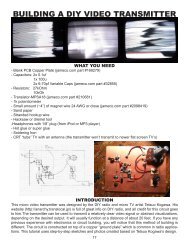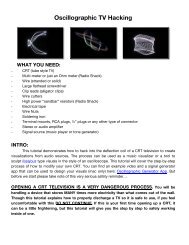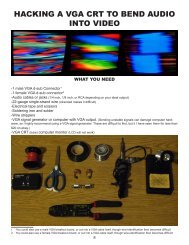CRACKING RAY TUBES - Cracked Ray Tube
CRACKING RAY TUBES - Cracked Ray Tube
CRACKING RAY TUBES - Cracked Ray Tube
Create successful ePaper yourself
Turn your PDF publications into a flip-book with our unique Google optimized e-Paper software.
<strong>Cracked</strong> <strong>Ray</strong> <strong>Tube</strong> is a collaborative realtime project that breaks and disrupts the interfaces of analog<br />
televisions and computer monitors to produce flashing, screeching, wobbulating, self-generated electronic<br />
noise and video.<br />
Our audio and video hacks for televisions and VGA computer monitors were first developed as independent<br />
projects, and collaboration grew out of their natural compatibility. With the computer monitors,<br />
the red, green, and blue video signals of the VGA cable are processed and fed back through<br />
a sound mixer simultaneously generating the audio and video information, which is received, deciphered<br />
and displayed by multiple computer monitors. On the other side, transmitted video is distorted<br />
through both physical contact with handmade circuitry and by electromagnetic flexing and folding of<br />
high powered electron beams within modified televisions. In both of our systems, the interfaces of<br />
the hardware are hacked, removed, and replaced with structures that function in a far less controlled<br />
and more chaotic manner, able to be manipulated through complex instrumentation resulting in unexpected<br />
outcomes that differ greatly from their intended use as commodities. Rather than using it to<br />
generate signals to be consumed by the viewer, we’re interested in examining the cathode ray tube<br />
as raw material in itself, as a physical object capable of breaking the viewer’s expectations of the<br />
familiar act of passively staring at television and computer screens. We’re interested in engaging with<br />
the methods developed by artists who have examined the cathode ray tube in its own aesthetic qualities<br />
including Ben Leposky’s Oscillons of the 1950s, the endless experiments of Nam June Paik, the<br />
Sandin Image Processor, as well as several artists currently working in the collaborative New Media<br />
art world, such as the Chicago group Arcanebolt.<br />
This document describes the way our system works through schematics and tutorials. It explains how<br />
to hack the communication networks of these hardwares in order to create new and alternative uses<br />
that differ from their intended purposes. This information is presented as a starting point from which<br />
your own methods of making, breaking, hacking, and restructuring can follow.<br />
James Connolly and Kyle Evans<br />
crackedraytube.com<br />
Copy-It-Right, 2011<br />
2






